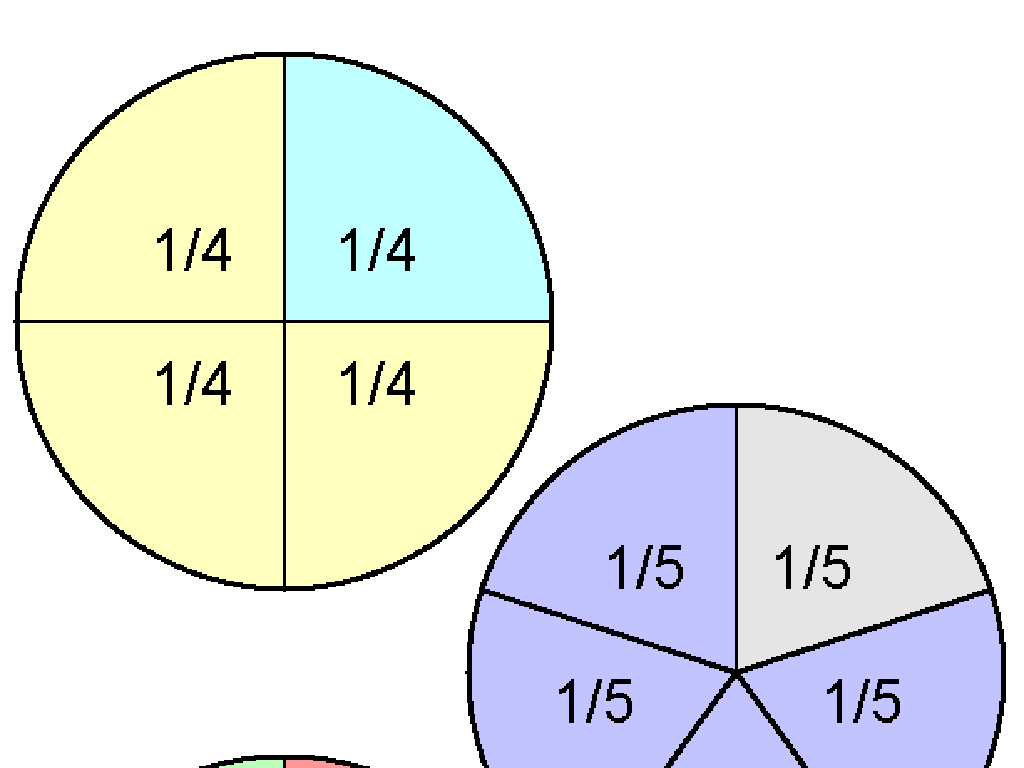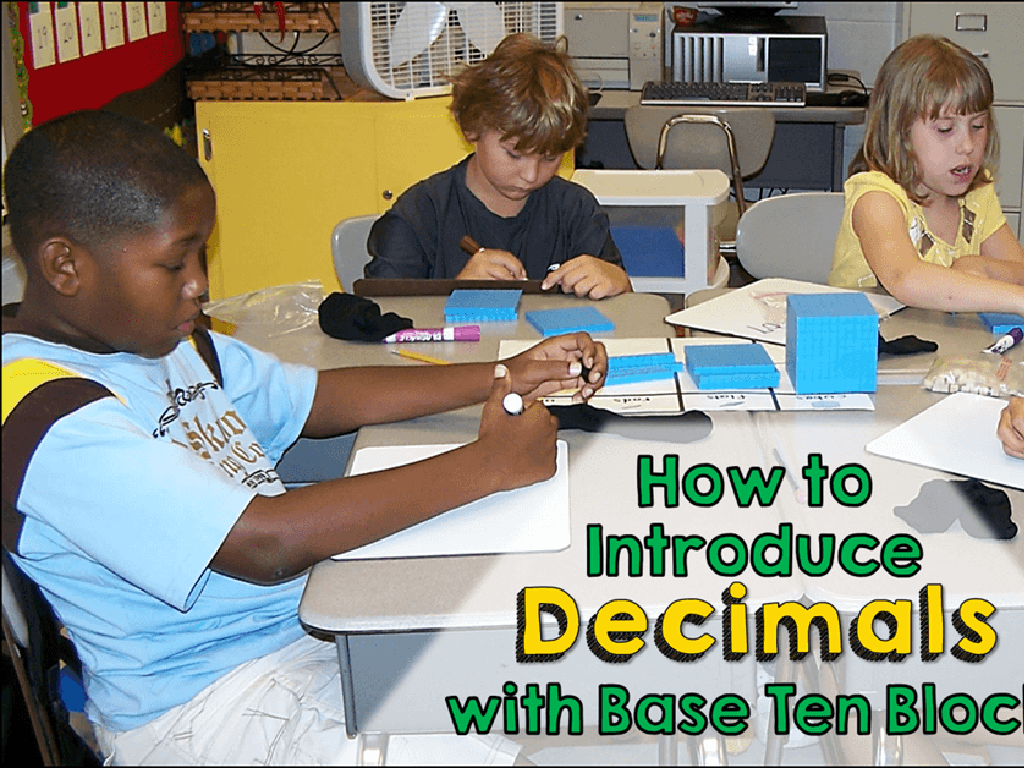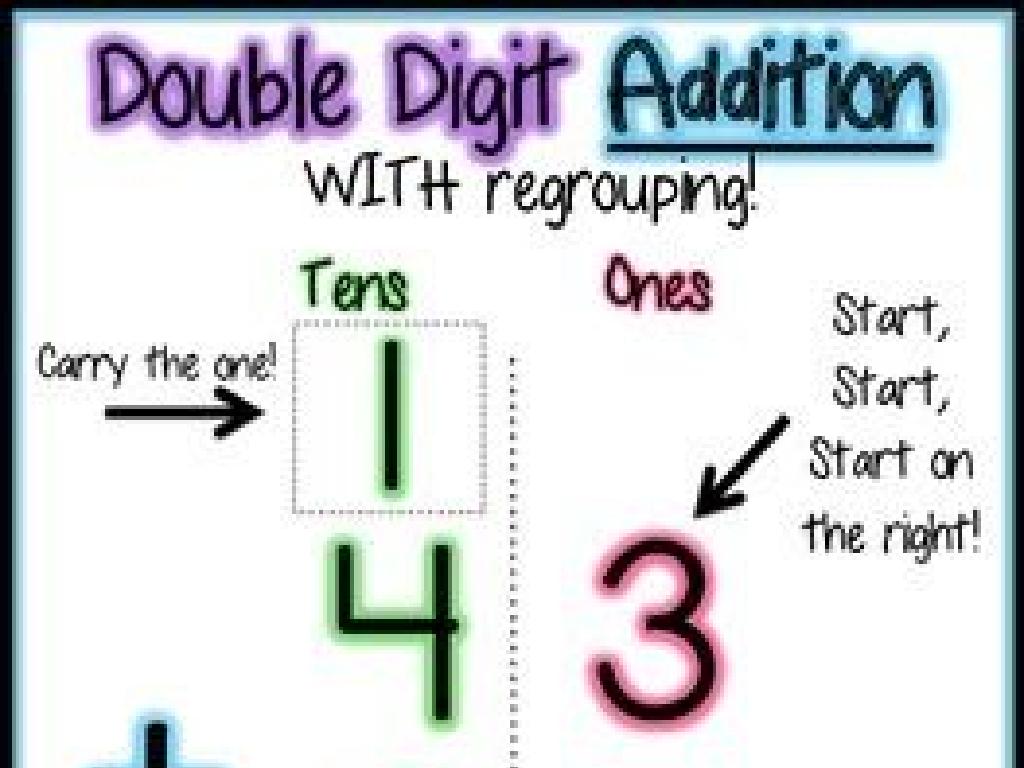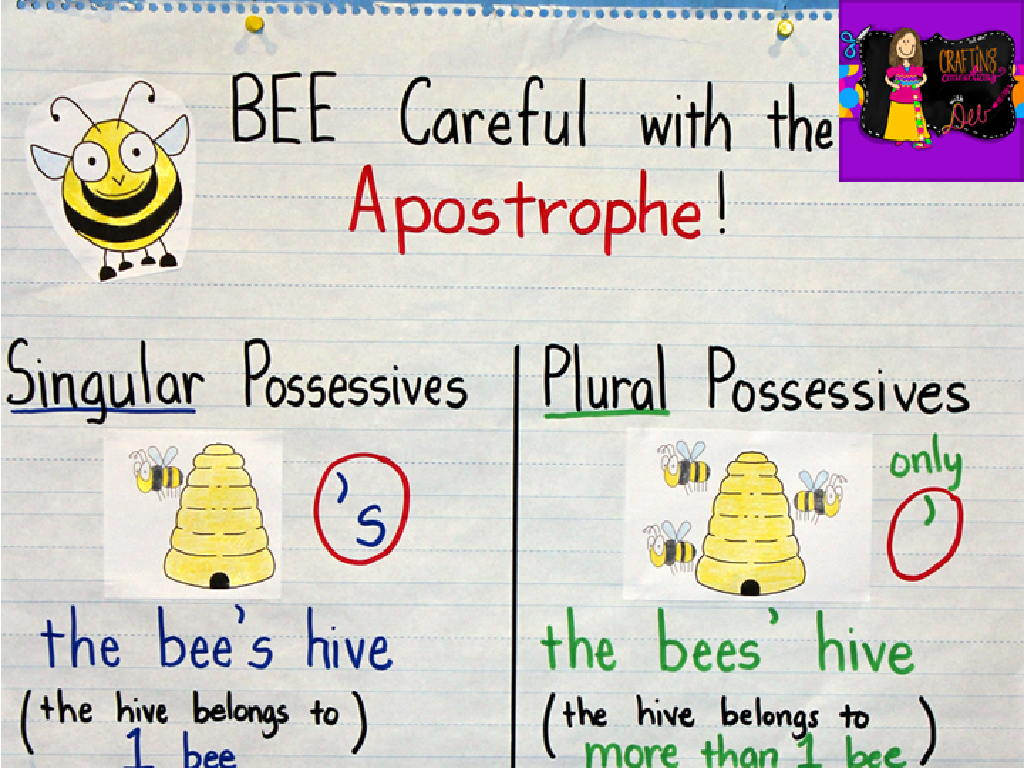Use The Correct Subject Or Verb
Subject: Language arts
Grade: Fourth grade
Topic: Verb Types
Please LOG IN to download the presentation. Access is available to registered users only.
View More Content
Today’s Adventure: Understanding Subjects and Verbs!
– Importance of correct subject-verb use
– Ensures sentences make sense and are grammatically correct.
– Verbs: action or state of being
– A verb tells what the subject does or is like: run, jump, is, are.
– Subject-verb agreement basics
– Subjects and verbs must match in number: He runs, They run.
– Practice makes perfect
|
This slide introduces the concept of subjects and verbs and their importance in sentence construction. Emphasize the need for correct subject-verb agreement to make sentences clear and grammatically correct. Review what a verb is, highlighting that it represents an action or a state of being. Explain the basic rule of subject-verb agreement, ensuring students understand that singular subjects take singular verbs and plural subjects take plural verbs. Include examples and encourage students to practice by creating sentences of their own. This will help solidify their understanding and prepare them for more complex sentence structures.
Understanding Subjects in Sentences
– What is a subject?
– The subject is the main focus of a sentence.
– Examples of subjects
– ‘The cat’, ‘My friends’, ‘The team’ are subjects.
– Identifying subjects activity
– We’ll find subjects in sentences as a class.
– Practice makes perfect
|
This slide introduces the concept of the subject in a sentence, which is a fundamental element of grammar for fourth graders. Begin by explaining that the subject is the person, place, thing, or idea that the sentence is about. Provide clear examples of subjects to illustrate the point. Engage the class with an interactive activity where students identify the subjects in various sentences. This could involve sentences written on the board or in their books. Encourage participation and provide immediate feedback to ensure understanding. As a follow-up, assign practice exercises for homework to reinforce the lesson.
Singular vs. Plural Subjects
– Singular subjects mean one
– For example, ‘The cat meows.’
– Plural subjects mean more
– For example, ‘The cats meow.’
– Verbs change with the subject number
– ‘Dog barks’ vs. ‘Dogs bark’
– Matching subjects with correct verbs
– We say ‘She runs’ not ‘She run’
|
This slide introduces the concept of subject-verb agreement to the students. It’s crucial for them to understand that verbs must match the number of the subject; singular subjects take singular verbs, and plural subjects take plural verbs. Use examples to illustrate how adding ‘s’ to a verb can change it from plural to singular, and vice versa. Encourage students to practice by identifying subjects in sentences and choosing the correct verb form to match. Provide additional examples and exercises to reinforce this concept.
Matching Subjects with Verbs
– Verbs must match subjects
– Singular subjects use singular verbs
– ‘He runs’ not ‘He run’
– Plural subjects use plural verbs
– ‘They laugh’ not ‘They laughs’
– Let’s practice this concept!
|
This slide introduces the fundamental rule of subject-verb agreement in sentences. It’s crucial for students to understand that verbs need to be in the correct form to match the subject’s number, whether it’s singular or plural. Provide clear examples to illustrate singular and plural agreement. During the practice activity, encourage students to create their own sentences or correct given sentences as a way to apply what they’ve learned. Offer a variety of exercises to cater to different learning styles, such as matching exercises, fill-in-the-blanks, and sentence rewriting. This will help reinforce the concept and ensure that students can accurately match subjects with their corresponding verbs.
Exploring Verb Types
– Action Verbs: show actions
– Like ‘run’, ‘jump’, and ‘think’.
– Linking Verbs: connect subject
– Such as ‘am’, ‘is’, and ‘are’.
– Helping Verbs: assist main verb
– Words like ‘has’, ‘might’, and ‘will’.
– Examples in sentences
– ‘She runs fast’, ‘He is happy’, ‘They have eaten’
|
This slide introduces students to the different types of verbs: action, linking, and helping verbs. Action verbs are easy to identify as they show what the subject is doing. Linking verbs, on the other hand, are used to connect the subject of the sentence to more information about the subject. Helping verbs are used alongside the main verb to express the tense or possibility. Provide examples for each type of verb and encourage students to create their own sentences using each type. This will help them understand how verbs function within a sentence and how they can change the meaning of a sentence.
Let’s Practice: Choosing the Right Verb
– Choose the correct verb for sentences
– Identify the subject in sentences
– Find who or what is doing the action
– Determine if the verb is singular or plural
– Does the subject sound like one or more than one?
– Partner up for practice sentences
– Two heads are better than one for learning!
|
This slide is designed for an interactive class activity to reinforce the lesson on subject-verb agreement. Students will practice selecting the appropriate verb based on the subject of each sentence. Start by reminding them that the subject is who or what the sentence is about, and the verb must agree in number (singular or plural). Encourage them to work in pairs to foster collaboration and discussion, which can lead to a deeper understanding of the concept. Provide a worksheet with practice sentences and space for students to write the correct verb form. As an extension, ask students to create their own sentences for their partner to complete. This activity will help solidify their grasp of subject-verb agreement in a fun, engaging way.
Class Activity: Verb Hunt
– Find sentences in a favorite book
– Identify the subject and verb
– Look for who or what is doing the action
– Check if they match in number
– Singular subjects need singular verbs; plural subjects need plural verbs
– Discuss findings with the class
|
This activity is designed to help students recognize and understand subject-verb agreement in sentences. Provide a brief review of subjects and verbs, emphasizing the importance of matching them in number (singular or plural). Encourage students to choose a book they enjoy and find sentences that they find interesting or challenging. They should underline the subject once and the verb twice, then write ‘S’ for singular or ‘P’ for plural next to each to indicate if they match. After the activity, ask students to share their sentences and explain their reasoning for the subject-verb match. This will foster a collaborative learning environment and allow for peer learning.
Conclusion & Homework: Mastering Subject-Verb Agreement
– Importance of subject-verb agreement
– It ensures sentences make sense and are grammatically correct.
– Homework: Craft 5 sentences
– Use different subjects and verbs you’ve learned.
– Circle the subjects in sentences
– Identifying the ‘who’ or ‘what’ of the sentence.
– Underline the verbs in sentences
– Find the action or state of being in each sentence.
|
Understanding subject-verb agreement is crucial for constructing sentences that are clear and grammatically correct. This foundational skill in English helps ensure that the subject (the ‘who’ or ‘what’ of the sentence) matches the verb (the action or state of being) in both number and person. For homework, students will reinforce this concept by writing five original sentences. They will practice identifying the subject and verb in each sentence by circling and underlining them, respectively. This exercise will help students recognize patterns and become more confident in their writing abilities. In the next class, we can review some of the sentences together to celebrate successes and clarify any misunderstandings.






